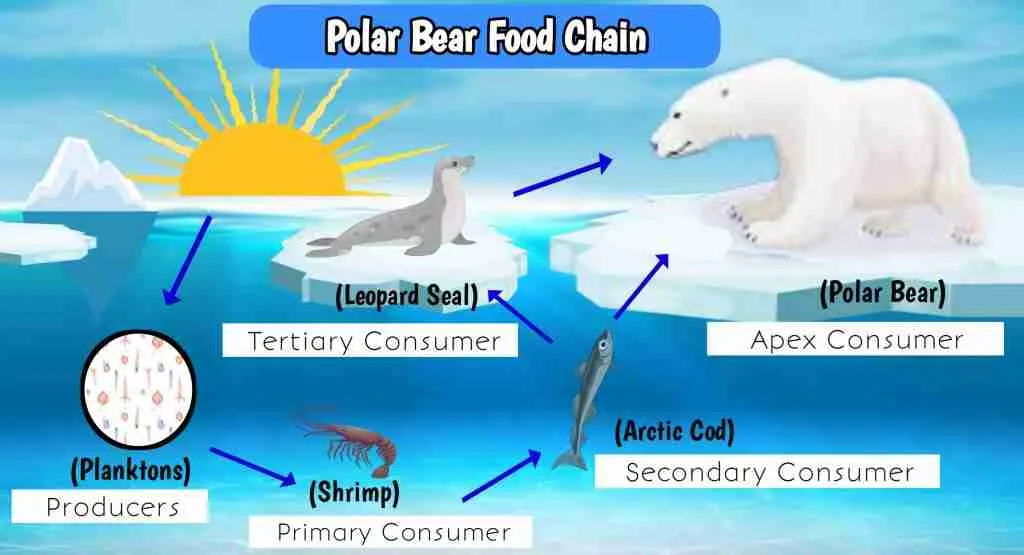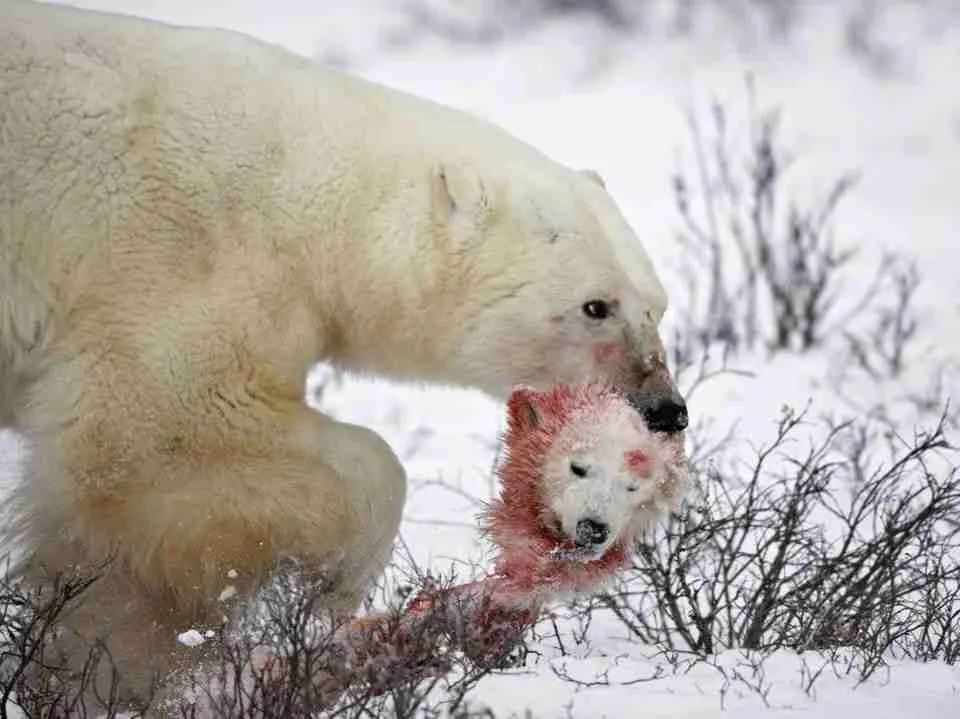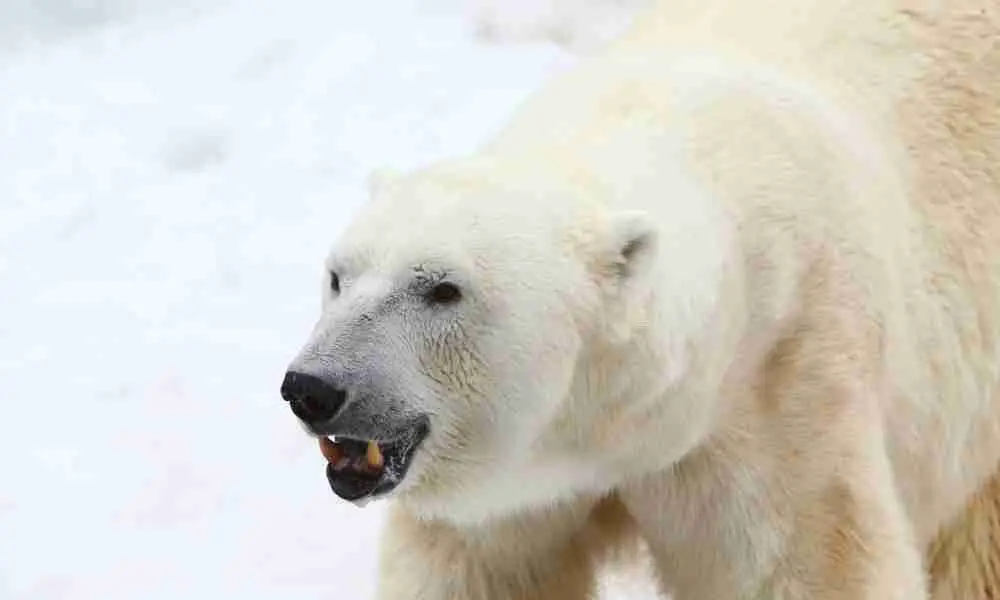Polar bears are powerful predators that can hunt almost any animal effortlessly. But does this mean they are considered apex predators of their habitat?
Here’s a quick answer :
Yes, polar bears are apex predators in their habitat. They occupy the top of their Arctic food chain and don’t have any natural predators.
In fact, these creatures are the biggest land predators in the world. They are great hunters who usually feed on seals, walruses, and other marine mammals.
Now that you know this, let’s take a closer look at what apex predators are. By doing so, you can tell why polar bears fall into this category and what makes them so special.
Keep reading!
What are Apex Predators?
Apex predators are animals that are at the top of their food chain with no natural predators. They are important for keeping the populations of other animals in check.
They also help to prevent a particular species from dominating the environment. This way, there’s a healthy balance in the ecosystem.
These predators are typically flesh-eaters and are known for their strength and agility. This gives them an advantage when hunting and catching their prey.
Additionally, apex predators are bigger and more powerful than other predators. They have sharp teeth and strong jaws used in killing and eating their prey.
That being said, let’s continue reading to find out why polar bears are considered apex predators.
6 Reasons Why Polar Bears Are Considered Apex Predators
Polar Bears Are Large and Powerful
Polar bears are the biggest land predators on the planet. Their adult males reach up to 1,500 pounds (680 kg) and stand over 8 feet (2.4 meters) tall on their hind legs.
They are powerful, and this allows them to hunt animals much bigger than themselves, such as walruses. However, they don’t have animals that hunt them in the wild.
They Have Sharp Claws And Teeth
Polar bears have some impressive features, such as their sharp and curved claws which measure about 4 inches long. They use these claws to dig for seals, grip slippery ice, and defend themselves.
In addition, polar bears have 42 teeth which are larger and sharper than that of other bears. Their bite force is incredibly strong, reaching up to 1200 pounds per square inch (psi).
The most dangerous part of the polar bears’ teeth is their canines, which they use to catch and kill their prey. They also have premolars which allow them to tear and chew their food.
Polar Bears Have A Keen Sense Of Smell
Polar bears have a strong sense of smell. It is a major advantage for them as apex predators, especially when it comes to hunting and surviving in the Arctic.
Their sense of smell is more than 100 times better than that of humans. It can detect a seal from a distance of 32km (20 miles) away.
Their ability to smell a seal that is 3ft beneath the ice from a 1km (0.6 miles) distance is even more interesting.
Polar Bears Are Solitary Hunters
Polar bears are loners. They only come together when they want to mate or occasionally hunt in pairs for larger prey such as walruses.
They are territorial and will always protect their space from other animals. These characteristics help polar bears and keep them at the top of the food chain in their environment.
Polar Bears Do Not Have Natural Predators
Adult polar bears have no natural predators in the wild. They sit at the top of their food chain and are in total control of their habitat.
Moreover, their intimidating looks make it difficult for any animal to come close or think of hunting them.
They Play A Major Role In The Arctic Environment
Aside from having different diets, polar bears play a major role in the Arctic ecosystem. They help to regulate the populations of other animals and spread nutrients throughout the environment.
Without the polar bears in their habitat, the Arctic would be seriously affected; Thus, the ecosystem would not be balanced.
Polar Bear Food Chain – Diagram

What Animal Eats Polar Bears?
Adult polar bears do not have natural predators. Nevertheless, there are a few animals that will eat polar bear cubs if they get the chance, They include:
Wolves
Wolves are known to be opportunistic hunters, taking advantage of any available prey, including polar bear cubs. They typically attack cubs that are less than one year old although it doesn’t happen every day.
In the Canadian Arctic, research revealed that wolves were responsible for the deaths of at least 13 young polar bears. This number of polar bear cubs died within one year.
The study found that these wolves were more likely after cubs that were separated from their mothers. In some cases, they form packs to distract the mother polar bear and then snatch the cub away.
Brown Bears
Brown bears are a species of bear found in the forests and mountain regions of Europe, North America, and Asia.
They are known for their strength and aggression, making them dangerous predators of polar bear cubs.
When ice sheets melt as a result of global warming, polar bears are forced to move inland in search of food. This also allows brown bears to travel further north to hunt their prey.
Now, when their habitat overlaps causing them to meet, brown bears will often prey on polar bear cubs younger than two years old.
Walruses
These huge seals are found in the Pacific and northern Atlantic Oceans, usually on rocky coastlines and ice floes.
Although they are not usually predators of polar bears, they’ve been known to kill polar bear cubs.
In 2015, a Walrus was found attacking and killing a polar bear cub that was separated from its mother. Studies stated that the cause of this attack was hunger due to malnutrition.
Moreover, Walruses are so large and strong that they can easily overpower polar bear cubs. However, it is important to know that it doesn’t happen often.
Other Polar Bears
Adult male polar bears may sometimes hunt and eat their young ones. This happens especially if the cub is not their own.
This habit is referred to as ‘’infanticide’’ and it is believed to be a way for male polar bears to reduce competition for resources and boost their chances of mating with the female.
Take Note:
Humans don’t usually prey on polar bears, but they can hunt them for their fur, and other body parts. And this has made them polar bears’ greatest predators.
What’s more, continuous hunting and poaching have caused a decrease in the polar bear population in some areas. So humans remain a major threat to polar bears’ survival in some parts of their region.
What Animals Do Polar Bears Prey on?
Polar bears mostly eat marine mammals, but they may also eat land animals. Here’s a list of animals they prey on:
- Seal – Polar bears mainly prey on ringed seals, but they also eat bearded seals, harp seals, and hooded seals.
- Walrus – Polar bears sometimes hunt and eat walruses. Nonetheless, this is not as frequent as they hunt seals.
- Whale – Polar bears may prey on the carcasses of whales that have been washed up on the shore or on the remains of whales that have been killed by orcas.
- Fish – Polar bears will eat fish such as salmon if they manage to catch them.
- Egg – Polar bears have been known to eat eggs from birds like geese, chicks, and ducks, particularly during summer when birds are nesting on the tundra.
- Muskoxen – Polar bears are usually associated with the Arctic marine environment, but they can also hunt Muskoxen for food.
- Caribou – Polar bears can also prey on Caribou when they come across them.
Cannibalism: Do Polar Bears Prey on Their Kind?

Yes, they do! Cannibalism is an uncommon but known behavior among some polar bears. Many times, they’ve been seen preying on other polar bears, including their young ones.
These bears are large and require a lot of sustenance to stay alive. So, if they don’t have enough to eat, they may settle to eat with each other.
Starvation is a real danger for these large animals. If two polar bears are competing for food, it becomes the perfect time to eat each other.
Eventually, one of them might get hurt during a fight. As a result, the other one can take advantage of the situation and eat the injured polar bear.
A study published in Polar Biology in 2017 showed that cannibalism among polar bears is more common than we thought. The research found that 11% of polar bear deaths were due to cannibalism.
And the evidence obtained from the study suggests that this cannibalism was due to food competition.
Take Note:
Climate change is generally the major cause of the increasing polar bears’ cannibalism. As the Arctic sea ice melts, polar bears are having a harder time finding food.
Are Polar Bears the Largest Land Predators?
Yes, polar bears are the largest land predators in the world. They are powerful apex predators that have adapted to hunting and surviving in their Arctic habitat.
Adult male polar bears can weigh up to 1,500 pounds (680 kg) and reach a height of 10 feet (3 meters) when standing on their hind legs. This makes them one of the biggest carnivores on the planet.
They have adapted to the extreme weather conditions of the Arctic, where they are at the top of the food chain.
Polar bears are highly specialized hunters, always using their sharp claws and teeth to kill and eat food. They also use their sense of smell and expert swimming skills to survive their daily life.
Polar Bears Predation – Active or Opportunistic?
Polar bears are active predators. They do not prey on animals only when they get the chance to do so.
Instead, they actively search for their prey and create chances themselves. These bears have to hunt regularly to feed.
They are experts at tracking down seals which are their primary food source. They also use different hunting techniques to catch and eat their prey.
These techniques include:
- Waiting by a breathing hole in the ice and ambushing seals when they surface to breathe.
- Stalking seals on the ice, then breaking through it to swim, pursue and catch them.
- Using their sharp sense of smell and excellent vision, to find and capture their prey.
- In some cases, they may feed on human food sources or even eat the remains of dead animals.
Related Questions:
Are Black Bears Apex Predators?
Yes, black bears are apex predators. This means they are at the top of the food chain in their environment and have no natural predators.
These animals are large, powerful, and skilled hunters. They eat a variety of food, such as berries, deer, elk, insects, and other small animals.
Black bears play a vital role in the environment. They help to manage the population of prey species and also spread nutrients around the ecosystem.
Are Brown Bears Apex Predators?
Yes, brown bears are apex predators in their habitats. They occupy the top of their food chain and have no natural enemies.
These powerful creatures are known for their hunting abilities. They can take down large animals like moose and caribou, as well as smaller ones like fish, rodents, and birds.
Most importantly, brown bears are important for keeping the balance of the ecosystem. They do this by regulating the numbers of prey species and providing food and shelter for other creatures.
Are Grizzly Bears Apex Predators
Yes, grizzly bears are apex predators with no natural predators. They are skilled hunters of ungulates such as elk, moose, and bison.
Grizzlies also eat a variety of other foods, including berries, insects, and fish. They are important to the ecosystem, as they help to keep prey populations in check.
Are Giant Pandas Apex Predators?
Yes, Giant pandas are the top predators in their environment. They are the biggest carnivores there with the adult ones having no natural predators.
Giant pandas are mainly bamboo eaters, but they are natural carnivores that use their sharp canines to hunt and catch small animals like pikas, rats, and other rodents.
Are Sloth Bears Apex Predators?
Yes, sloth bears are apex predators. This signifies that they are at the top of their food chain and do not have any natural predators.
They feed on rodents, birds, and carrion, but their primary diet consists of ants and other insects. These bears have strong jaws and teeth that allow them to crush the bones of their prey.
They play a huge role in the environment, making sure that the number of plants and animals in their habitat is balanced.
Recap
To conclude, polar bears are apex predators. They are found at the top of their food chain and have no natural enemies.
These animals are considered apex predators because of the following reasons:
- Polar bears have a large size and strength that allows them to overpower their prey.
- They have sharp claws and teeth which they use to kill and eat any animal they catch.
- Polar bears also have a strong sense of smell that allows them to perceive their prey from a distance.
- They are solitary hunters
- They do not have natural predators.
- They help to control the population of animals in their Arctic habitat.
Despite this, predators such as wolves, brown bears, walruses, and even other polar bears, often target young polar bears.
Interestingly, they can not try that with the adult species.
Many times, and if you are thinking if it’s possible to tame a polar bear. Could it work? It’s a bad idea! Read our article to learn about ‘’15 Reasons Why Polar Bears Can’t Be Tamed’’

